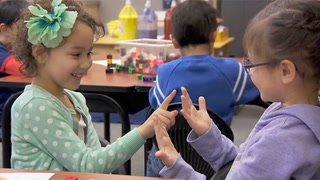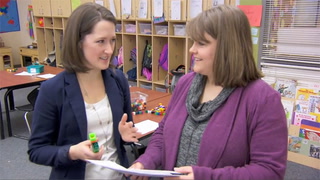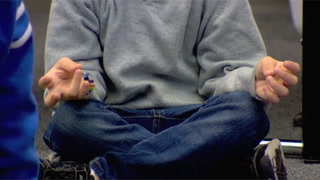Teacher Collaboration... While Teaching! Transcript
Card:
Tch
TeachingChannel
+++ 00:00:03 +++
Kristin Alfonzo: Let's start with Amirah.
Kendra Lomax: Start with Amirah? Okay. And them maybe somebody who did it similarly could add on.
Kristin Alfonzo: Mm-hmm.
+++ 00:00:10 +++
Kristin Alfonzo: Kids know in our school that teacher timeouts and huddles are things that happen and they know how to kind of continue working or transition themselves on while teachers decide how to be their best selves next.
Card:
Classroom Strategy:
Teacher Collaboration...
While Teaching!
Lower Third:
Kristin Alfonzo
Kindergarten Teacher
South Shore PK-8, Seattle WA
+++ 00:00:26 +++
Kristin Alfonzo: Teacher timeouts are something that teachers often use when they're collaborating with each other or co-teaching side by side, to say, "Let's stop. Have you thought about asking this question?" or "Why don't you put it this way?" or "I was wondering if we tried this." And a huddle would be where two teachers or a group of teachers might come back and look at student work or discuss next steps.
+++ 00:00:48 +++
Ellen Kleyman: I'm thinking that will just answer the two questions that the children identified.
Sarah Dietz: Mm-hmm.
Ellen Kleyman: I think it's good that kids see that teachers are learners as well.
Lower Third:
Ellen Kleyman
K-2nd Grade Mathematics Specialist
Graham Hill Elementary, Seattle WA
+++ 00:00:58 +++
Ellen Kleyman: And I think it's good that they see the work that we're doing as messy and imperfect, and that we're all revising our thinking and learning as we go. So I think it keeps things dynamic.
Card:
2nd Grade Mathematics
Graham Hill Elementary, Seattle WA
+++ 00:01:13 +++
Sarah Dietz: Miss Ellen is here today and we are going to do some mathematical thinking.
Lower Third:
Sarah Dietz
2nd Grade Teacher
Graham Hill Elementary, Seattle WA
Sarah Dietz: On the days that she's here, she and I co-teach together and really work off of each other.
+++ 00:01:23 +++
Ellen Kleyman: So actually, these two are interesting, because they're trying to figure out-- they're jumping back to the 26. He's subtracting the 26.
Sarah Dietz: Right.
+++ 00:01:33 +++
Ellen Kleyman: Collaboration here really helps us, I think, do our best work in the moment, because there's someone to think with and talk with and bounce ideas off of. Today it happened when we wanted to look at some kids' work and decide which strategies we wanted to present to the whole group.
Sarah Dietz: Let's start with Tashaun.
Ellen Kleyman: Okay.
Sarah Dietz: And then let's go to Luis.
+++ 00:01:56 +++
Sarah Dietz: When Ellen's in the room, we'll often take teacher timeouts and talk with each other about what we think-- where we want to go next, what's the next move we want to make. Is there a strategy that we want to highlight that we missed?
Sarah Dietz: Do we want to take some time to analyze the differences?
Ellen Kleyman: That's what I was wondering about, making the connections maybe even Luis's way and Aaron's way?
+++ 00:02:23 +++
Sarah Dietz: Yeah, okay. So I noticed something and I'm wondering if you guys noticed it as well. What do you see that is the same, and what did you see that is different between Aaron's way and Luis's way? Can you just take a moment to just look at that?
Card:
Kindergarten Class
South Shore PK-8, Seattle WA
+++ 00:02:41 +++
Kristin Alfonzo: Miss Lomax is here on the carpet with us because she's here to help us really think about some of the strategies we've all used.
Kendra Lomax: We could go outside of the classroom after the lesson is all over and say, "Gosh, I wish we had tried this."
Lower Third:
Kendra Lomax
Mathematics Teacher Educator
University of Washington, Seattle WA
Kendra Lomax: But that moment's over and gone. So if we can do it in the moment, we have a chance to change the course of the lesson.
+++ 00:03:00 +++
Kendra Lomax: What did you see kids doing?
Kristin Alfonzo: I saw almost every group doing a drawing of some kind, making sure they had six.
Kendra Lomax: Mm-hmm.
Kristin Alfonzo: And nine, and adding them all together. I also noticed that at least three groups got hung up on their estimate.
Kendra Lomax: Yeah.
+++ 00:03:16 +++
Kristin Alfonzo: And even though they had a correct drawing or a correct model, they didn't want to move on from that number.
Kendra Lomax: Yeah, so that was a new idea we kind of tried today, estimating. So maybe that would be good to address.
+++ 00:03:27 +++
Kristin Alfonzo: During the huddle today, we were talking about the student work and all of the different strategies and modeling strategies we had seen from the kids, and we were talking about what specifically we wanted to highlight during the share out, so that we didn't have disjointed perspectives from the kids, but really took those few minutes of precious learning time to really highlight a strategy and some thinking that we wanted the other kids to hear.
+++ 00:03:51 +++
Kendra Lomax: So maybe we can use one of the models where the kids drew six and they drew nine and they counted all together.
Kristin Alfonzo: Mm-hmm.
Kendra Lomax: And then after we've kind of established that, come back to some of the ones some of us today thought that it was 11, because that was a really good guess.
Kristin Alfonzo: Mm-hmm. It's okay if our first guess isn't the accurate answer.
+++ 00:04:08 +++
Kendra Lomax: Yeah, but estimating helps us keep track of that situation and like what would be reasonable.
Kendra Lomax: As teachers, we always make a really good plan ahead of time, but things change in the moment when we see what kids actually do. So being able to huddle is like recreating that plan. Now that we have more information from our students, what do we want to focus this conversation on?
+++ 00:04:29 +++
Kristin Alfonzo: Did any of you, like Amirah, get stuck on your first good idea, your first good guess?
Students: Yeah.
Ellen Kleyman: People have to be open to collaborating with each other. When we do, we're more creative, we're more responsive to the children in the room.
Kristin Alfonzo: It helps simply because if I just kept going without doing a sidebar, the share out wouldn't be as rich.
+++ 00:04:49 +++
Sarah Dietz: It's very helpful to me as the classroom teacher, because it's two heads are better than one.
Kristin Alfonzo: Is there anything else we want to add about Amirah's strategy, Miss Lomax?
+++ 00:04:57 +++
Kendra Lomax: Well, I was just noticing that that's one thing that mathematicians do, is they make really good guesses sometimes, and sometimes they revise their thinking, based on what they see. So that's exactly what Amirah did today.
+++ 00:05:08 +++
Kristin Alfonzo: Mm-hmm. That's a great thing to do in math.
Card:
The University of Washington would like to thank the colleagues that helped to create these innovative strategies for teacher collaboration.
Teresa Lind,
Jessica Calabrese Granger,
And the staff of Lakeridge Elementary
Card:
Tch















17 Comments
Tammy Barnes Feb 25, 2021 11:38am
Great video and ideas
Juan Muro Apr 27, 2018 2:14am
Rahma Sadellah Mar 19, 2018 4:45pm
Victoria Jones Feb 18, 2018 8:06pm
Juan Fernando López Nov 9, 2017 12:56pm